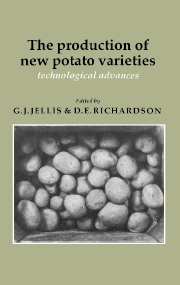Book contents
- Frontmatter
- Contents
- List of contributors
- Preface
- Editors' note and acknowledgements
- Introduction
- The development of potato varieties in Europe
- Genetic Resources
- Breeding Strategies
- Selection and Screening Methods
- Variety Assessment
- Semi-conventional Breeding Methods
- Efficient utilization of wild and primitive species in potato breeding
- Advances and limitations in the utilization of Neotuberosum in potato breeding
- Breeding at the 2x level and sexual polyploidization
- Haploids extracted from four European potato varieties
- Heterosis for tuber yields and total solids content in 4x x 2x FDR-CO crosses
- Variability of F1 progeny derived from interploidy (4x x 2x) crossing
- Unreduced gametes in the breeding of potatoes at the diploid level
- Desynapsis and FDR 2n-egg formation in potato: its significance to the experimental induction of diplosporic apomixis in potato
- Utilizing wild potato species via Solanum phureja crosses
- The use of diploid Solanum phureja germplasm
- Advances in population breeding and its potential impact on the efficiency of breeding potatoes for developing countries
- True Potato Seed
- Unconventional Breeding Methods
- Commentary
- Index
Utilizing wild potato species via Solanum phureja crosses
Published online by Cambridge University Press: 05 March 2012
- Frontmatter
- Contents
- List of contributors
- Preface
- Editors' note and acknowledgements
- Introduction
- The development of potato varieties in Europe
- Genetic Resources
- Breeding Strategies
- Selection and Screening Methods
- Variety Assessment
- Semi-conventional Breeding Methods
- Efficient utilization of wild and primitive species in potato breeding
- Advances and limitations in the utilization of Neotuberosum in potato breeding
- Breeding at the 2x level and sexual polyploidization
- Haploids extracted from four European potato varieties
- Heterosis for tuber yields and total solids content in 4x x 2x FDR-CO crosses
- Variability of F1 progeny derived from interploidy (4x x 2x) crossing
- Unreduced gametes in the breeding of potatoes at the diploid level
- Desynapsis and FDR 2n-egg formation in potato: its significance to the experimental induction of diplosporic apomixis in potato
- Utilizing wild potato species via Solanum phureja crosses
- The use of diploid Solanum phureja germplasm
- Advances in population breeding and its potential impact on the efficiency of breeding potatoes for developing countries
- True Potato Seed
- Unconventional Breeding Methods
- Commentary
- Index
Summary
Wild potato species are an immense source of genetic variability which has been relatively little used. Many diploid and tetraploid wild species are compatible with diploid clones of Solanum phureja cultivated on the Andes of South America. The resulting hybrids can have various levels of ploidy:
a) diploid, 2n = 24 (wild diploid x cultivated diploid)
b) triploid, 2n = 36 (wild tetraploid x cultivated diploid)
c) tetraploid, 2n = 48 (wild tetraploid x cultivated diploid producing 2n gametes.
Gene transfer from wild to cultivated clones in the case of a) diploid and b) triploid hybrids is assured by utilizing them as male parents, which may produce 2n pollen grains by First division restitution or Second division restitution in the meiotic process, in order to fertilize tetraploid cultivars or clones of S. tuberosum ssp. tuberosum or spp. andigena. In the case c), in which the hybrids produced are tetraploid, gene transfer is more simple since the hybrids can be used either as males or females in backcrosses to tuberosum or andigena tetraploid clones.
By this method, hybrids were obtained from crosses between S. phureja clones and 12 species (S. acaule, S. andreanum, S. boliviense, S. bulbocastanum, S. chacoense, S. Colombianum, S. microdontum, S. sanctaerosae, S. sogarandinum, S. stoloniferum, S. toralapanum and S. vernei) belonging to seven taxonomic series (Figure 1).
- Type
- Chapter
- Information
- The Production of New Potato VarietiesTechnological Advances, pp. 229 - 230Publisher: Cambridge University PressPrint publication year: 1987

